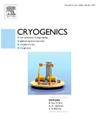Quasi-3D thermal–hydraulic analysis of the cool-down for CFETR CSMC
IF 1.8
3区 工程技术
Q3 PHYSICS, APPLIED
引用次数: 0
Abstract
The cool-down of large Cable-in-Conduit Conductor (CICC) superconducting magnets presents significant complexity, necessitating careful management to ensure operational safety. This study proposes a quasi-three-dimensional thermal–hydraulic analysis model, developed using COMSOL Multiphysics, specifically designed for large CICC superconducting magnets. The model facilitates an in-depth analysis of the 300 K-80 K cool-down for the Central Solenoid Model Coil (CSMC) of China Fusion Engineering Test Reactor (CFETR). The proposed numerical model is capable of successfully constraining the maximum temperature difference among the various components of the magnet while providing an accurate depiction of the temperature distribution throughout the cool-down. Furthermore, it incorporates the inter-turn heat transfer within the coils. This article discusses improvement suggestions for the cool-down of the CSMC and presents the results after these enhancements. This study also investigates the effects of varying inlet pressures and maximum temperature differences on the cool-down of the magnet. The results offer valuable theoretical insights for future cool-down experiments, thereby helping to mitigate the risk of damage to the magnet due to inappropriate cool-down parameters.
CFETR CSMC冷却过程的准三维热水力分析
大型导管内电缆导体(CICC)超导磁体的冷却非常复杂,需要仔细管理以确保运行安全。本研究提出了一个准三维热液分析模型,使用COMSOL Multiphysics开发,专门为大型中金超导磁体设计。该模型有助于对中国核聚变工程试验堆(CFETR)中央电磁模型线圈(CSMC)的300 K-80 K冷却进行深入分析。所提出的数值模型能够成功地限制磁体各部件之间的最大温差,同时提供整个冷却过程中温度分布的准确描述。此外,它还结合了线圈内的转间传热。本文讨论了CSMC冷却的改进建议,并介绍了这些改进后的结果。本研究还探讨了不同进口压力和最大温差对磁体冷却的影响。该结果为未来的冷却实验提供了有价值的理论见解,从而有助于降低由于不适当的冷却参数而导致磁铁损坏的风险。
本文章由计算机程序翻译,如有差异,请以英文原文为准。
求助全文
约1分钟内获得全文
求助全文
来源期刊

Cryogenics
物理-热力学
CiteScore
3.80
自引率
9.50%
发文量
0
审稿时长
2.1 months
期刊介绍:
Cryogenics is the world''s leading journal focusing on all aspects of cryoengineering and cryogenics. Papers published in Cryogenics cover a wide variety of subjects in low temperature engineering and research. Among the areas covered are:
- Applications of superconductivity: magnets, electronics, devices
- Superconductors and their properties
- Properties of materials: metals, alloys, composites, polymers, insulations
- New applications of cryogenic technology to processes, devices, machinery
- Refrigeration and liquefaction technology
- Thermodynamics
- Fluid properties and fluid mechanics
- Heat transfer
- Thermometry and measurement science
- Cryogenics in medicine
- Cryoelectronics
 求助内容:
求助内容: 应助结果提醒方式:
应助结果提醒方式:


